17 Plants that Thrive Under Oak Trees

Plants that grow well under oak trees should tolerate shade and drought and not have deep roots. Landscaping under oak trees can be challenging. Even though the majestic trees are beautiful, it isn’t easy to find plants that thrive under oaks. However, with careful planning and the right plant selection, you can create a beautiful and thriving landscape under an oak tree.
This article explores several landscaping options for under an oak tree’s canopy. You will learn which plants grow well closer to the oak tree trunk. Also, you will find plant descriptions of flowers and shrubs that grow a few feet from the trunk.
Challenges of Planting Under Oak Trees
Planting under oak trees can be challenging due to the dense shade they create, which limits sunlight for other plants. Another obstacle is the extensive and strong root systems of oak trees, which compete with surrounding plants for water and nutrients. Oak trees prefer acidic soil, which may not be suitable for certain plant types.
The roots around an oak tree are relatively shallow, typically one to two feet (30 – 60 cm) deep. Therefore, it’s important to avoid digging too deep or too close to the trunk to prevent damage to the tree’s delicate roots. The roots in the area closest to the oak tree’s trunk are particularly sensitive, making it unwise to plant anything next to the base of the tree.
Oak trees are known for their sprawling branches that create deep summer shade. When selecting plants, ensure they can thrive in these shady conditions.
Oak trees endure wet winters and store water for the hot summer months when they require minimal watering. Excessive summer irrigation can make oaks vulnerable to lethal fungal diseases. Therefore, it’s crucial to choose plants that are drought-tolerant and require minimal irrigation.
The best plants for landscaping under an oak tree should be drought-tolerant, have shallow roots, and perform well in deep shade and neutral to acidic soil. To enhance the plants’ chances of thriving, mulch with 2-3 inches of organic matter. But keep the area close to the base of the oak tree free from mulch.
Do not remove the natural leaf mulch around oak trees unless there is a significant risk of fire. This organic material decomposes slowly, providing essential nutrients to the soil, conserving water, and improving soil structure.
Plants That Grow Closer To The Oak Tree Trunk
Despite the challenges of growing plants under an oak tree canopy, some flowers, bulbs, ground cover plants, and ferns can grow relatively close to the trunk.
Crocuses (Crocus)
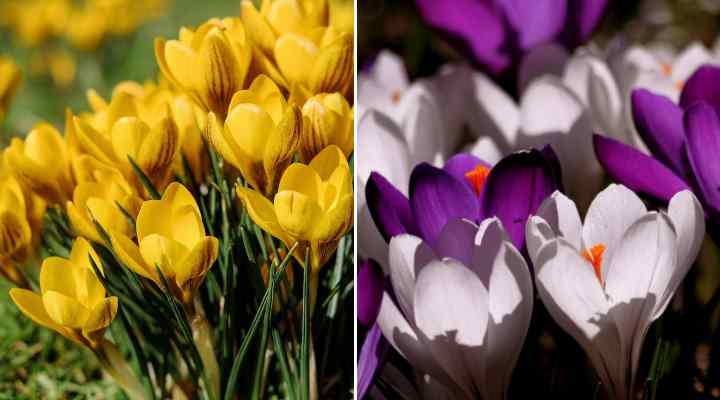
Crocuses are beautiful spring-flowering bulbs that perform well under oak trees. The early-blooming bulbous plants have small, cup-shaped flowers and delicate grass-like foliage. Typically, flowers appear before oaks have fully leafed out. Additionally, crocuses grow 2” to 3” (5 – 7.5 cm) deep in the soil, so there is little risk of damaging oak tree roots.
Crocus thrive in partial shade and dappled sunlight, which makes them one of the best plants to grow under trees. The purple, pink, white, yellow, and lilac flowers provide a burst of color in the landscape. Crocuses are easy to plant and require minimal care, making them a great choice for adding color close to the base of oak trees.
- USDA Planting Zone: 3 to 8
- Sun Exposure: Full sun to partial shade
- Blooming Season: Early spring
- Mature Size: 4” to 6” (10 – 15 cm) tall and wide
- Growth Rate: Fast growth rate, doubling in number every three years
Creeping Phlox (Phlox stolonifera)
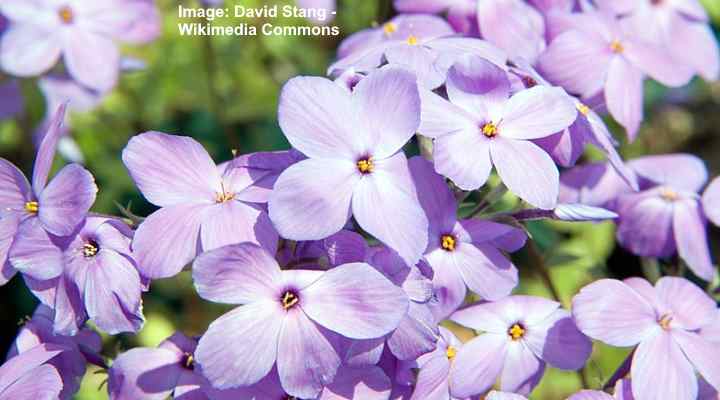
Creeping phlox is a purple-flowering ground cover plant that thrives in the deep shade of oak tree canopies. This low-growing mat-forming perennial blooms in summer with star-shaped fragrant flowers. The purple flowers contrast beautifully with the green, oval leaves. Creeping phlox grows up to 8” (20 cm) tall.
Creeping phlox is an excellent choice for adding color and texture to the understory of oak trees. Its dense mat of foliage prevents weed growth and soil erosion. The plant is also deer-resistant and attracts butterflies and bees to summer gardens with its nectar-rich flowers.
- USDA Planting Zone: 4 to 8
- Sun Exposure: Full sun, partial shade, deep shade
- Blooming Season: Late spring throughout summer
- Mature Size: 3” to 8” (7.5 – 20 cm) tall and up to 2 feet (0.6 m) wide
- Growth Rate: Moderate to fast-spreading
Lady Fern (Athyrium filix-femina)
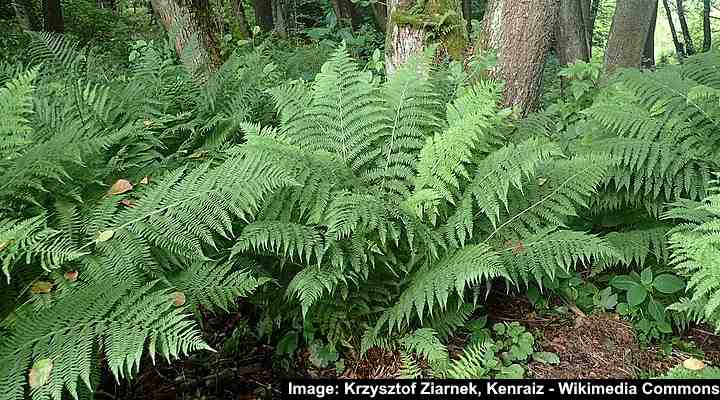
Lady fern is popular for understory oak tree planting close to the trunk due to its shade tolerance. This deciduous fern features delicate, light-green fronds growing in shuttlecock-like clumps. The lush, feathery foliage grows easily in deep shade, providing welcome greenery under large oak trees. It grows up to 3 ft. (1 m) tall.
Lady fern is one of the few deciduous ferns that tolerates exceptionally dry soil. The cool, shaded conditions under the dense canopy of an oak tree are ideal for growth. It grows in small clumps and is ideal for landscaping a shaded woodland garden.
- USDA Planting Zone: 4 to 8
- Sun Exposure: Partial shade to full shade
- Mature Size: 1 to 3 ft. (0.3 – 1 m) tall and wide
- Growth Rate: Moderate growth rate, forming dense clumps over time
Virginia Bluebells (Mertensia virginica)

Virginia bluebells are beautiful, bell-shaped lilac-blue flowers that thrive in the dense shade of oak trees. Blooming in early spring, the native wildflowers are clusters of bell-shaped nodding flowers 1” (2.5 cm) across. The understory native plant has smooth, oval blue-green leaves measuring 4” (10 cm) long.
Virginia bluebells look stunning when growing massed around oak trees. Along with crocuses, they provide early spring color to bare landscapes. They spread slowly, eventually creating a large colony of delicate purple flowers. The delightful flowers attract butterflies, hummingbirds, and bees early in the season.
- USDA Planting Zone: 3 to 8
- Sun Exposure: Partial shade to full shade
- Blooming Season: Early to mid-spring
- Mature Size: 1 to 2 ft. (0.3 – 0.6 m) tall and wide
- Growth Rate: Slow growth rate, forming a large colony over time
Barrernwort (Epimedium spp.)

In the picture: Red barrenwort (Epimedium × rubrum)
Barrenwort is a group of versatile flowering plants ideal for planting under oak trees. They thrive in deep shade and dry soil. Barrenwort plants are identified by their open sprays of flowers with wiry petals, heart-shaped leaves, and stunning bronze-purple foliage in the fall. The eye-catching flowers bloom in spring in shades of pink, white, yellow, and purple.
Barrenwort grows up to 24” (60 cm) in acidic, dry soils with minimal sunlight. It’s easy to grow and slowly spreads to cover the ground under an oak tree’s canopy. It is also resistant to deer, rabbits, and drought.
- USDA Planting Zone: 5 to 8
- Sun Exposure: Partial shade to full shade
- Blooming Season: Throughout spring
- Mature Size: 1 to 2 ft. (0.3 – 0.6 m) tall and wide
- Growth Rate: Slow growth rate, forming attractive ground cover over time
Creeping Lily Turf (Liriope spicata)
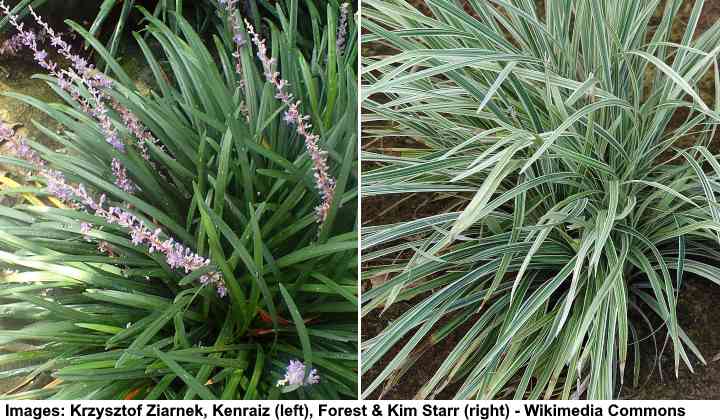
Liriope spicata (left) and Liriope spicata ‘Variegata’ (right)
Creeping lily turf is a hardy perennial ideal for planting in the shade of oak trees. The ground cover plant forms dense clumps of arching grass-like foliage in shaded conditions. It blooms in late summer with small spikes of lavender or white flowers. It grows up to 24” (60 cm) tall and wide.
Creeping lily turf is an excellent choice for adding texture and color to areas under oak trees. This ornamental grass is a good turfgrass alternative, which is notoriously difficult to grow near oak trees. Creeping lily turf tolerates shade, drought, salt, and acidic soils. Also, it requires minimal maintenance once established and is deer-resistant.
- USDA Planting Zone: 6 to 11
- Sun Exposure: Full sun, partial shade, full shade
- Blooming Season: Late summer to early fall
- Mature Size: 10” to 24” (25 – 60 cm) tall and wide
- Growth Rate: Slow to moderate, forming dense clumps over time
Periwinkle (Vinca minor)

Periwinkle, or creeping myrtle, is ideal for ground cover around a mature oak tree. This shade-loving mat-forming purple-flowering plant thrives in dry soil—ideal for underplanting oak trees. It has glossy, evergreen leaves and small, star-shaped flowers in shades of blue, purple, or white. Periwinkle spreads up to 2 ft. (0.6 m) wide.
Periwinkle is easy to grow and requires little maintenance, making it a popular choice for planting around oak trees. It is also deer-resistant and tolerant of dry conditions. The vibrant five-petalled purple flowers and glossy leaves add beauty and color to shaded areas, creating a lush and inviting landscape.
- USDA Planting Zone: 4 to 9
- Sun Exposure: Full sun, partial shade, full shade
- Blooming Season: Spring to early summer
- Mature Size: 4” to 6” (10 – 15 cm) tall and spreading up to 2 ft. (0.6 m) wide
- Growth Rate: Vigorous growth and quickly covers bare ground in oak woodlands
Beach Strawberry (Fragaria chiloensis)

The beach strawberry can grow well near an oak tree trunk as it is tolerant of shade and drought. The evergreen perennial plant blooms in spring. It is identified by its glossy, dark green lobed leaves and masses of small, five-petalled white flowers. In late summer, small red berries cover the plant.
The beach strawberry is well adapted to the conditions where oak trees grow. It’s ideal for growing as a dense evergreen ground cover under oak trees. Because it’s a good lawn substitute, beach strawberry is a suitable landscaping option for oak woodland gardens.
- USDA Planting Zone: 4 to 9
- Sun Exposure: Full sun to partial shade
- Blooming Season: Mid-spring through summer
- Mature Size: 4” to 6” (10 – 15 cm) tall and up to 3 feet (1 m) wide
- Growth Rate: Moderate to fast
Coral Bells (Heuchera maxima)

Coral bells is a common ground cover plant for dry shade conditions under oak trees. The shade-loving perennial plant has large, rounded, lobed leaves and white bell-shaped flowers growing on tall spikes. The conical flowering clusters and slightly fuzzy leaves add texture to woodland floors. The flowers attract hummingbirds and butterflies to landscapes.
Coral bells prefer slightly acidic soil and can tolerate dry conditions, making them ideal for planting under pine trees. They are also deer-resistant, making them a low-maintenance option for any garden. Coral bells add color and interest to the shade garden with their vibrant foliage and delicate flowers.
- USDA Planting Zone: 4 to 9
- Sun Exposure: Partial shade to full shade
- Blooming Season: Late spring to early summer
- Mature Size: 1 to 2 ft. (0.3 – 0.6 m) tall and wide
- Growth Rate: Clumping plant with moderate growth rate
Plants That Grow a Few Feet From Oak Trees
A variety of understory perennials and small shrubs flourish toward the edges of an oak tree canopy. These plants usually thrive in dappled sunlight and have root systems that don’t interfere with oak tree roots.
Douglas iris (Iris douglasiana)

Some varieties of irises, such as the Douglas iris (Iris douglasiana), are ideal for landscaping a few feet from oak trees. Depending on the specific variety, some iris plants can tolerate partial shade, although they generally prefer full sun. Planting them very close to the trunk of an oak tree might not provide the ideal growing conditions for them, especially if the area is heavily shaded.
Douglas iris is an example of an iris variety that can grow a few feet away from oak trees. Native to the coastal regions of North and Central California, Douglas iris is an attractive purple-flowering plant that blooms in spring. The shade-tolerant evergreen clumping perennial has bluish-purple flowers and sword-shaped arching leaves. This iris is an ideal native plant for landscaping shaded areas under tree canopies, adding color and texture.
Douglas iris can provide a habitat for moths and butterflies. Its attractive flowers can attract these pollinators, making it a valuable plant to consider under oak trees.
- USDA Planting Zone: 7 to 9
- Sun Exposure: Full sun to partial shade
- Blooming Season: Late spring to early summer
- Mature Size:1 to 2 ft. (0.3 to 0.6 m) tall and 2 to 4 ft. (0.6 – 1.2 m) wide
- Growth Rate: Slow, forming clumps over time
Encore Azaleas (Rhododendron)
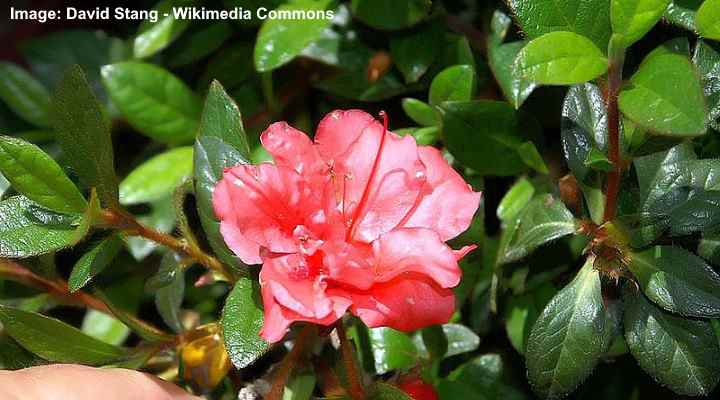
Azalea encore ‘Autumn Princess’
Azalea shrubs are popular for landscaping under oak trees because they thrive in acidic soil and partial shade. These flowers bloom in spring, and some rebloom in late summer and fall. Dwarf Encore azaleas have clusters of showy trumpet-shaped flowers blooming in shades of pink, red, purple, and white.
Encore azaleas are evergreen shrubs that need some sunshine to perform well. Therefore, azaleas are good landscaping options for planting around the drip line. You can create a colorful display by planting small shrubs as a specimen plant or in groups. Azaleas are low-maintenance plants not growing more than 3 ft. (1 m) tall.
- USDA Planting Zone: 6 to 10
- Sun Exposure: Full sun to partial shade
- Blooming Season: Spring, reblooming in the summer and fall
- Mature Size: 2 to 3 ft. (0.6 – 1 m) tall and wide
- Growth Rate: Moderate to fast growth rate, around 12” (30 cm) annually
Hostas (Hosta spp.)
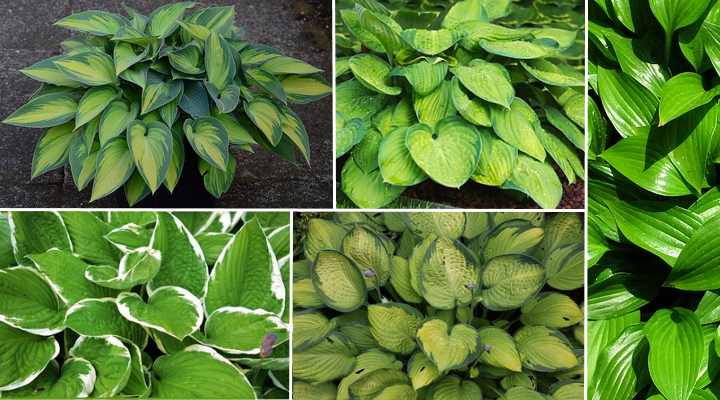
Hostas are shade-loving perennial plants well-suited for growing under the shaded canopy of oak trees. The hardy, low-care perennials have large, broad, oval leaves with various shades of green—sometimes variegated patterns. The lush, clumping foliage doesn’t grow taller than 3 ft. (1 m), but most are smaller plants.
Hostas thrive in poor soil and are good landscaping options for preventing soil erosion and weed control. They also bloom in late spring with clusters of small white flowers on tall spikes. However, because they require regular moisture, hostas may require additional watering when growing under an oak.
- USDA Planting Zone: 3 to 9
- Sun Exposure: Partial shade to deep shade
- Blooming Season: Late spring and early summer
- Mature Size: 2 to 3 ft. (0.6 – 1 m) tall and wide, but some varieties grow up to 6 ft. (1.8 m)
- Growth Rate: Slow growing, taking up to four years to reach maturity
Mountain Snow Pieris (Pieris japonica ‘Planow’)

The mountain snow pieris thrives at the edge of an oak tree canopy because it tolerates shade and drought. This compact, slow-growing shrub features abundant clusters of white, bell-shaped flowers dangling gracefully from reddish stems. Blooming in early spring, the brilliant white flower clusters contrast beautifully with the glossy, dark green lanceolate leaves.
The mountain snow pieris thrives in most soil types, and its shade and drought tolerance make it suitable for underplanting in oak tree environments. Also, the ornamental shrub grows less than four feet (1.2 m) tall, ideal for adding grace and elegance to the area under a majestic oak. Its compact size makes it suitable for small gardens or containers.
- USDA Planting Zone: 4 to 8
- Sun Exposure: Partial shade to full shade
- Blooming Season: Early spring
- Mature Size: 3 to 4 ft. (0.9 – 1.2 m) tall and 2 to 3 ft. (0.6 – 1 m) wide
- Growth Rate: Slow growth rate, forming a compact mound over time
Evergreen Currant (Ribes Viburnifolium)

Evergreen currant is a low-growing shrub that performs well in dappled sunlight at the edges of oak tree canopies. The fruit-producing evergreen shrub has glossy, dark green leaves and clusters of small, fragrant pink or purple flowers followed by showy dark red berries. The shrub grows up to 3 ft. (1 m) tall.
Evergreen currant is a popular ground cover landscaping option for shaded ground under oaks and deciduous trees. Its long, arching branches and sprawling habit cover bare patches of ground. It’s also drought-tolerant and performs well in dry shade. This low-maintenance shrubby plant requires minimal pruning and care and has a dense, spreading habit.
- USDA Planting Zone: 5 to 11
- Sun Exposure: Partial shade to full shade
- Blooming Season: Late winter to early spring
- Mature Size: 2 to 3 ft. (0.6 – 1 m) tall and up to 6 ft. (1.8 m) wide
- Growth Rate: Slow to medium growth rate
Hummingbird Sage (Salvia spathacea)

Hummingbird sage grows well in an oak tree’s shade due to its tolerance to dry shade, drought, and most soil types. The red-flowering perennial plant blooms in spring and summer with rose-pink blossoms in dense whorls. The other eye-catching feature of the ornamental plant is its arrow-shaped, aromatic, scalloped green leaves.
Hummingbird sage performs well as an understory ground cover plant in oak woodlands. It spreads vigorously by underground rhizomes, forming a dense mat of semi-evergreen foliage. In mild climates, it remains evergreen, growing under coast live oaks, blue oaks, and California black oaks.
- USDA Planting Zone: 8 to 11
- Sun Exposure: Full sun to partial shade
- Blooming Season: Spring and summer
- Mature Size: 1 to 3 ft. (0.3 – 1 m) tall and 3 to 5 ft. (1 – 1.5 m) wide
- Growth Rate: Moderate to vigorous growth rate
Creeping Mahonia (Mahonia repens)

Creeping mahonia brightens areas under oak canopies with its long-blooming golden-yellow flowers. Also called Oregon grape, this low-growing, shade-tolerant evergreen shrub thrives in well-drained acidic soils and partial shade. However, it blooms best at the edge of oak trees, where it gets more sunlight.
Creeping mahonia features shiny, dark green, holly-like leaves. In cooler climates, the foliage turns purple-bronze in the fall, adding color to the understory of oak trees. Also, small bunches of grape-like berries appear in late summer, attracting birds and wildlife to garden landscapes. It’s also deer and rabbit-resistant.
- USDA Planting Zone: 5 to 8
- Sun Exposure: Full sun to partial shade
- Blooming Season: Spring
- Mature Size: 1 to 2 ft. (0.3 – 0.6 m) tall and 1 to 3 ft. (0.3 – 1 m) wide
- Growth Rate: Slow to moderate growth rate
Dwarf Rose (Rosa gymnocarpa)

Dwarf rose is a compact shade-loving shrub with pink flowers that performs well under oak trees. This low-growing rose has delicate five-petalled, flat, open-faced pink flowers blooming in spring. The flowers contrast with pinnately divided leaves on prickly stems, followed by small, red fruits in the fall.
Dwarf roses are ideal for adding color and fragrance to shaded areas under oak trees. Their moderate growth rate forms a dense ground cover over time. Because they have a shallow root system, they don’t compete with oak trees for nutrients in moist or dry soils.
- USDA Planting Zone: 5 to 9
- Sun Exposure: Full sun, partial shade, and full shade
- Blooming Season: Late spring to early summer
- Mature Size: Up to 3 ft. (1 m) tall and 3 to 9 ft. (1 – 2.7 m) wide
- Growth Rate: Moderate
Landscaping Ideas Around the Dripline of Oak Trees
When landscaping around the dripline of oak trees, it is best to choose native or adapted plants that can handle the dappled sunlight and acidic soil often found under oak trees. Under the drip line, you can plant small azaleas, wood roses, barberry shrubs, and boxwoods. You can landscape around your oak to create a low hedge or spaced apart for a more open feel.
To ensure the success of your landscaping project, consider using a layer of mulch to help retain moisture and regulate soil temperature. Avoid piling mulch against the tree trunk, as this can lead to moisture-related issues. Instead, maintain a small gap around the base of the tree to promote healthy airflow. Regular maintenance, including pruning, weeding, and monitoring for pests and diseases, is crucial to keeping your landscaping looking its best.
What is The Best Time To Plant Under Oak Trees?
The best time to plant under your oak trees is in the fall, particularly in late fall. This period is optimal because oak trees tend to absorb the most moisture they require for the year during this time and in winter. Planting during this season allows the plants to establish their roots in preparation for the following year.
The dry summer months are not ideal for planting due to the oak trees’ preference for dry conditions. Constant watering during this period can potentially lead to fungal issues in newly planted vegetation.
How to Water Newly Planted Plants Under Oak Trees
When watering newly planted plants under oak trees, it’s important to avoid overwatering the area. Drip hoses and sprinklers should be avoided as they can provide excessive water to the oak tree. Instead, opt for manually watering the new plants using a hose or watering can, focusing solely on the plants themselves.
Water the plants infrequently, giving them light drinks of water every few days during the initial period and extended dry spells. Keep in mind that most of the plants on the list are drought-tolerant and can withstand dry conditions.
Best Oaks to Landscape Under
You must choose understory plants wisely for landscaping under oak trees. However, some native oak trees are particularly apt for growing perennials and shrubs under the canopy. Here are a few native oaks that work well with plants growing a few feet from the trunk.
Willow Oak (Quercus phellos): This native willow oak tree is excellent for underplanting due to its slender, willow-like leaves. The foliage allows dappled sunlight to filter through, creating an ideal environment for understory plants. It’s drought-tolerant and low-maintenance, and its graceful form adds an elegant touch to the landscape.
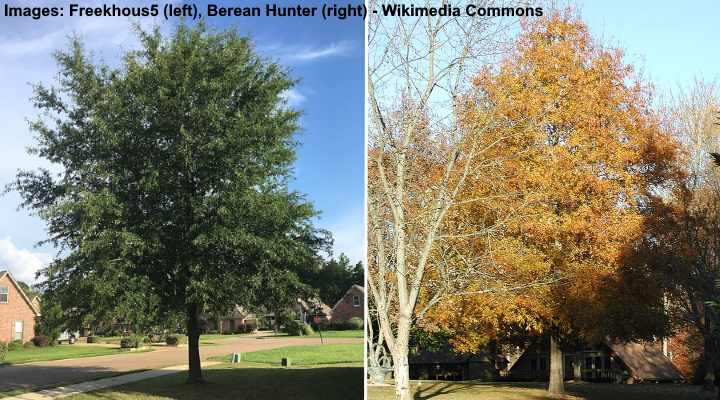
Willow oak trees. Right picture: Willow oak in autumn
Shumard Oak (Quercus shumardii): This type of red oak has a large, spreading canopy, providing a balance of sun and shade. This creates dappled sunlight for plants growing under its canopy. Also, its tolerance to various soil types and drought resistance make it a robust choice as a hardy shade tree. In addition, the oak has vibrant autumn foliage, adding visual interest to fall landscapes.
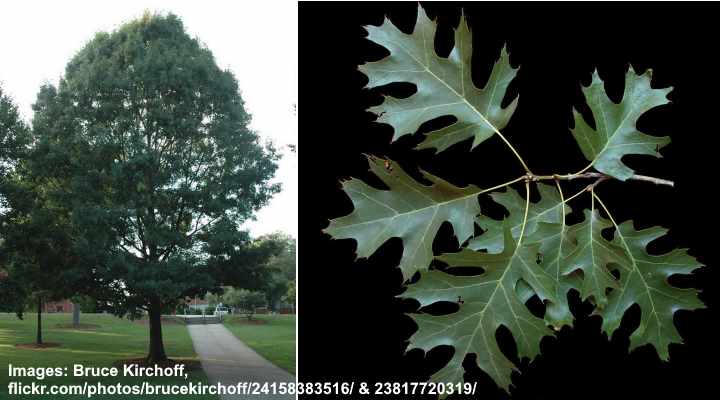
Shumard oak tree and leaves
Northern Red Oak (Quercus rubra): This native oak is an attractive deciduous tree with pointed lobed leaves and dense canopy. Many shade-tolerant plants thrive in the tree’s shadows, and the oak displays a stunning fall color when the leaves turn deep red.
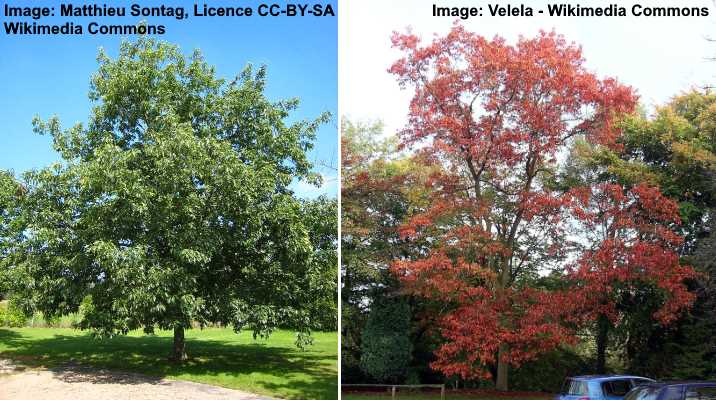
Northern red oak trees. Right picture: Willow oak in autumn
Scarlet Oak (Quercus coccinea): This oak grows in most parts of the United States and is ideal for light shade in landscapes. The oak tree is tolerant of varying soil types and urban conditions. Its stunning red fall foliage persists past the first snowfall.
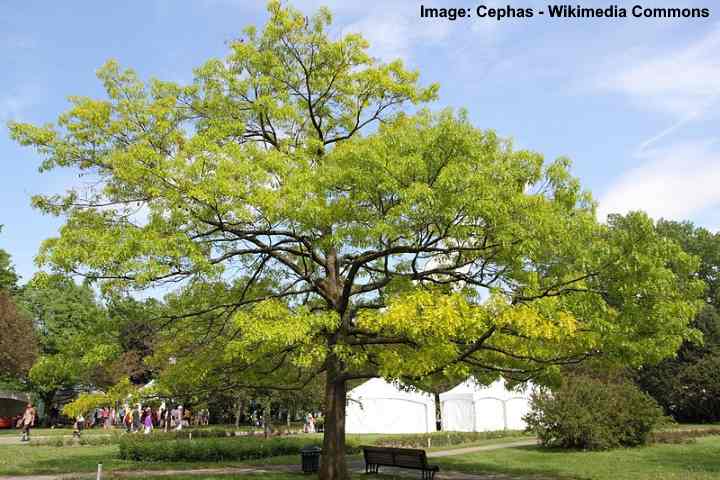
Scarlet oak tree
Related articles:
